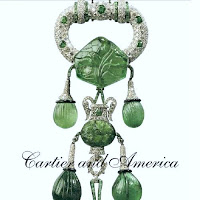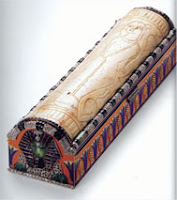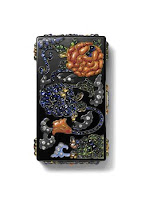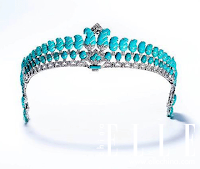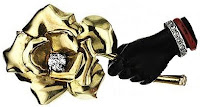This is the epilogue (I swear!) to the three part series on the incredible CARTIER and AMERICA exhibit at the Palace of the Legion of Honor in San Francisco, CA.
The show runs through April 18, 2010

Above: An artists rendering of the Cartier, New York store.
Cartier, founded in Paris in 1847, the final year of the French monarchy and the dawn of the Second Empire, the firm quickly attracted an international following in addition to French aristocrats, but also Russian princes and wealthy Americans. It was the belle epoque era, and Cartier expanded to London in 1902, and the United States in 1909, to capitalize on a potentially large customer base of wealthy industrialists and other well-heeled Americans who encountered Cartier on trips to Paris.
___________________________________________

Phot0: The Mexican actress, Maria Felix (Mexico’s Joan Collins?), wearing her famous jeweled double crocodile necklace, with a few hundred carets of other things and species.
_________________________________________________
The extravagant bijou in this show, however, can seem relatively modest compared to the life-size serpent necklace created for Maria Felix (married four times), the Mexican film star and femme fatale who understood (as did the brothers Cartier, perhaps more profoundly) that seduction begins with caprice. Her alarming chef d’oveuvre, which takes tow hands to hold and was two years in the making, has an ingeniously articulated body of 2,473 diamonds, set in platinum and gold, that weigh just over 178 carats; on its underside, the red, black and green enamel scales area as flat and cool to the touch as a snake’s belly.

Photo, above: Snake Necklace, made for Mexican film star, Maria Felix. Cartier Paris, 1968.
___________________________________________________

Photo, above: Crocodile Necklace, another distinctive piece made for the actress Maria Felix. Cartier Paris, 1975
Felix also asked Cartier to reproduce her two pet crocodiles in yellow diamonds and Colombian emeralds, and when her husband gave her an enormous emerald solitaire, she pretended to believe that it was an earring and asked him for its pair, where upon they were added to the necklace.
Made in gold, and set with 1,023 brilliant-cut fancy intense yellow diamonds weighing 60.02 carats in total; two navette-shaped emerald cabochons, 1,060 emeralds weighing 66.86 carats in total, and two ruby cabochons.
I read that Ms. Felix actually had the two live crocodiles delivered to Cartier, and asked them to hurry and measure them before they grew any larger, because they were the size of the necklace she wished to have made.
For God’s sakes!
__________________________________________________



Photos
Left: American actress Grace Kelly, photographed for the cover of Life Magazine (April 1955) after she won the Oscar for Best Actress, for Country Girl (1954).Center: The Life Magazine Cover
Right: Graces Kelly’s engagement ring from Prince Ranier of Monaco
For the first time, an American museum features the personal jewelry of Princess Grace of Monaco (from the time of her wedding to Ranier III, Prince of Monaco, in 1956).
Among the items lent by the princess; children Prince Albert, Princess Caroline, and Princess Stephanie, is her engagement ring, a 10.47-carat emerald-cut diamond set with two baguette diamonds mounted in platinum (which she wore on the set of her last film, the 1956 movie “High Society” before she became Princess of Monaco.



Photos
Left: Hen Brooch, Cartier Paris, 1957. Gold, platinum, diamonds, emerald, mother of pearl, pears, and coral. It appears that the Princess had a sense of humor.
Center: Necklace, Cartier Paris, 1953. Diamonds and platinum.
Right: A trio of clip Brooches, Cartier Paris, 1955. Diamonds, rubies, platinum and gold.
Grace Kelly’s death in 1982 was a big surprise, The princess of Monaco, who was only 52 and seemingly in perfect health, suffered a stroke while driving with her daughter Princess Stephanie. It was just as she was driving on the edge of the upper Corniche, and the stroke left her incapacitated and unable to control the car. It careened off the edge of the mountain and rolled down, flipping several times. Princess Stephanie suffered fracture and some bruising and survived, but Princess Grace died from her injuries.
___________________________________________________________
A few other extraordinary things:


Photos above:
Left: Tiara, Cartier Paris, 1914. Blackened steel, diamonds, rubies, and platinum.
Center: Tiara, Cartier London, 1937. Citrines, gold, diamonds, and platinum.
Right: Tiara, Cartier Paris, 1914. Diamonds, onyx, pearls, platinum and enamel.
Photos, above:
Left: Egyptian sarcophagus vanity case. Cartier Paris, 1925. Bone, enamel, gold, emeralds, sapphires, diamonds, platinum, and mirror (sold to Mrs. George Blumenthal, aunt of Katherine Graham the former editor of the Washington Post).
Center: Tiara, Cartier London, 1936. Turquoises, diamonds and platinum.
Right: Vanity case, Cartier Paris, 1927. Sapphires, emerald, coral, moonstone, topazes, gold, enamel, diamonds, platinum and mirror.
Photos, above:
Detailed working drawings, left, for the Rose Clip brooch, shown finished at right. Cartier Paris, 1938. Gold, enamel, diamonds, silver and platinum.
_______________________________________________
Photos
Left: The view from the front door of the Palace of the Legion of Honor Museum, looking toward past the glass pyramid, Rodin’s “Thinker”, and Mark di Suvero’s sculpture, to San Francisco Bay.
Right: The Marin (county) headlands.
As we left the museum we were struck by the awesome beauty of this setting. The enclosed columned courtyard anchored by Rodin’s imposing bronze sculpture, The Thinker, seemed to be contemplating the elegant and colossal di Suvero sculpture in the distance, juxtaposed with the abstract beauty of the Marin headlands, and the smell of the salt air from the powerful ocean below.
__________________________________________________________
I’m done! Yippee!
Oh…except I haven’t told you about the Mystery clocks!
How they work:
The central crystals are located in Brazil (sometimes they’ll use a topaz); it not only has to be flawless, but sufficiently light and transparent. The lapidary then cuts it into a six, eight, or twelve sided shape.
The rock crystal at the heart of the clock is cleaved into two perfectly matched halves, which are then scooped out. Into the hollows are placed two crystal discs with sawtooth edges to which the clock’s hands are attached, making the hands seem to float and spin around the dial of their own accord.
That’s it.
Really!






